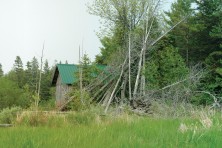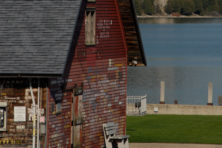Preserving the Door’s Landscape
- Share
- Tweet
- Pin
- Share

As Door County residents and visitors, we are drawn to the area’s natural beauty. Fortunately, we have many public and private organizations, not to mention individual landowners, working to ensure that Door County’s beauty and environmental diversity are preserved for future generations.
To date, Door County contains more than 38,500 individual tax parcels, over 22,000 of which have “improvements.” Less than 17% of the county’s total land area of 312,015 acres is considered permanently protected. Permanently protected areas include federal, state, county, and municipal parks; natural areas and wildlife refuges; non-governmental preserves; school-owned lands; and privately owned lands bound by conservation easements.
As an individual property owner, you can employ a wide variety of land protection measures in addition to conservation easements, none of which require public access to your property. Many Door County property owners have added restrictions on the deeds to their property that limit future development. (Note that if you do not designate a specific group or agency to permanently enforce the deed restriction, your wishes may later be ignored.) There are managed forest programs in which you may enroll, as well as programs available to help you (re)establish wildlife habitats, wetlands, ponds, and other natural areas. Agricultural landowners also have the option of entering into a temporary farmland preservation agreement with the state.
The primary public organizations that own and continue to acquire land in Door County for preservation purposes include the Wisconsin Department of Natural Resources, the University of Wisconsin, various federal agencies, our local municipalities, and the county itself. Many of these public agencies have programs that might be helpful to you in your efforts to protect and enhance natural features of your property.
The main private, nonprofit organizations involved in land protection efforts within Door County are The Ridges Sanctuary, The Nature Conservancy, the Door County Land Trust, and the Door County Green Fund.
The Ridges Sanctuary
The Ridges Sanctuary, located in Baileys Harbor, was founded in 1937 after local and seasonal residents learned of the County of Door’s plans to develop the 40-acre parcel containing the 1869 Range Lights with roads and a campground/trailer park. A group of ten men and women formed The Ridges Sanctuary, Inc., began leasing the parcel from the county, and slowly began acquiring adjacent lands for protection as well. Thanks in part to their efforts, Baileys Harbor today contains both the highest density and the highest number of rare species of any municipality in the state.
Probably the most recognized name today among the original founders of The Ridges Sanctuary is Emma Toft, who, in addition to remaining active with The Ridges for nearly 50 years, also helped permanently protect hundreds of additional acres in Baileys Harbor. Local legend has it that the feisty Toft threw herself down in front of the county’s bulldozers as they were coming to clear portions of The Ridges for roads and campsites. In fact, the county did begin clearing land in 1936, but it was two other Baileys Harbor residents and founding members of The Ridges, Olivia Traven and Anna McArdle, that stopped the process. As you would expect, the real method used to halt the bulldozer-like machine – visits and phone calls to attorneys and local park system staff – is less entertaining than the legend.
Now more than 1,200 acres, The Ridges Sanctuary has over 3,000 members. It became a State Natural Area in 1967 and is also a National Natural Landmark. Federally endangered and threatened plant species find refuge in this boreal forest, as well as the endangered Hines Emerald dragonfly. Portions of The Ridges Sanctuary are open to the public for hiking; maps are available at the Nature Center on the property.
The Nature Conservancy
The Nature Conservancy, a private nonprofit land trust, was first established in the U.S. in 1951 with the mission of protecting habitats for rare species and rare natural communities. The Conservancy is now one of the largest nonprofit conservation organizations in the world, with project areas in over 25 countries.
Mike Grimm, Conservation Ecologist with the local Conservancy chapter, notes, “The Nature Conservancy has been working in Door County since 1962, when the organization was asked to help The Ridges in a particular land acquisition effort. Since that date, the Conservancy has protected over 5,000 acres in Door County, 3,000 of which we still own.” (The remaining 2,000 are managed by other conservation organizations and public agencies.) With its six project areas, The Nature Conservancy is the largest private landowner in Door County. Many of the Conservancy’s properties are open to the public for hiking and deer hunting, and snowmobile clubs are allowed to continue using lands purchased by the Conservancy that contain existing state-sponsored club trails.
In addition to acquiring land for conservation purposes, the Conservancy also develops educational programs for and conservation easements with individual landowners to help them protect the environmentally significant aspects of their property. The Nature Conservancy has over 21,000 members in Wisconsin.
The Door County Land Trust
Executive Director Dan Burke states that “the Door County Land Trust was established in 1986 with the mission of protecting, preserving and maintaining lands that contribute significantly to the scenic beauty and ecological integrity of Door County.” To fulfill this mission, the Land Trust enters into conservation easement agreements with property owners and also purchases properties outright. Burke notes that maps are available that depict the locations of the properties the Land Trust owns and manages that are open to various types of public recreation, such as hiking, canoeing, and hunting.
The Land Trust has over 1,400 members and owns and manages 900 acres in Door County. The Trust also holds conservation easements with about 40 property owners in the county, meaning that the trust is responsible for managing the permanent protection of an additional 1,400 acres in the county. Like The Nature Conservancy, the Door County Land Trust is involved in a wide variety of educational efforts in the county, in addition to its direct land protection efforts.
The Door County Green Fund
Modeled after the successful Nantucket Green Fund, the Door County Green Fund was established in 1998 to help permanently protect a wide variety of open space areas in the county. Founding board member and local business owner Vicki Wilson explains, “The Door County Green Fund specifically encourages membership contributions from the local business community, because there is an inherent connection between protection of our local environment and protection of the local economy.”
The Green Fund annually awards grants to private, nonprofit organizations and municipalities involved in a variety of land protection efforts; the fund itself does not own land nor the development rights to any land. Since the Green Fund’s inception in 1998, member contributions have assisted in the acquisition of green space by the Village of Ephraim, Crossroads at Big Creek, The Door County Land Trust, The Nature Conservancy, and the City of Sturgeon Bay.
Conservation easements are contracts property owners volunteer to enter into with private land trusts or public agencies that limit, or in some cases prohibit, the future development of designated properties. With the establishment of a conservation easement, the property owner sells or makes a tax-deductible donation of the development rights for the property to the land trust but retains ownership of the property. The owner is not prohibited from selling the property or leaving it to heirs, but future owners must also abide by the terms of the conservation easement. The designated land trust is permanently responsible for monitoring and enforcing the easement, through legal action if necessary. A conservation easement never requires public access be granted to the property.
Private Nonprofit Organizations
The Ridges Sanctuary: P.O. Box 152, Baileys Harbor, WI, 54202. (920) 839-2802. Director/Naturalist: Paul Regnier.
The Nature Conservancy: 311 Pennsylvania Street, Sturgeon Bay, WI, 54235. (920) 743-8695. Conservation Ecologist: Mike Grimm.
The Door County Land Trust: P.O. Box 345, Ephraim, WI, 54211. Sturgeon Bay office: (920) 746-1359. Baileys Harbor office: (920) 839-9990. Executive Director: Dan Burke.
The Door County Green Fund: P.O. Box 622, Sturgeon Bay, WI, 54235. (920) 495-6639. Board President: Mariah Goode.
County, State, and Federal Agencies
Door County Planning Department: (920) 746-2323. Wide variety of maps available, including currently protected lands in the county, and contact names and numbers for local neighborhood groups involved in land protection efforts.
WI Department of Natural Resources Foresters: (920) 746-2880. Information on forest planting programs and general forestry information.
WI Department of Natural Resources Landowner Contact Specialist with the Endangered Resources Program: (608) 267-9789. Assists landowners in protecting endangered species residing on their lands.
WI Department of Natural Resources Wildlife Biologist for Door County: (920) 755-4983.
U.S. Department of Agriculture Natural Resources Conservation Service: (920) 388-2792. Information on programs available to farmers as well as financial assistance programs for other landowners wishing to establish wildlife habitats.
U.S. Fish and Wildlife Service: (920) 866-3650. Information regarding a variety of wildlife/habitat restoration programs.
Door County Soil and Water Conservation Department: (920) 746-2214. Staff work with landowners on agricultural practices, erosion and storm water runoff control, and can provide information on low-cost tree and plant shipments available each spring.
Door County University of Wisconsin-Extension: (920) 746-2260. Information regarding agricultural programs available to landowners in the county and on Wisconsin nurseries that stock native plants.








